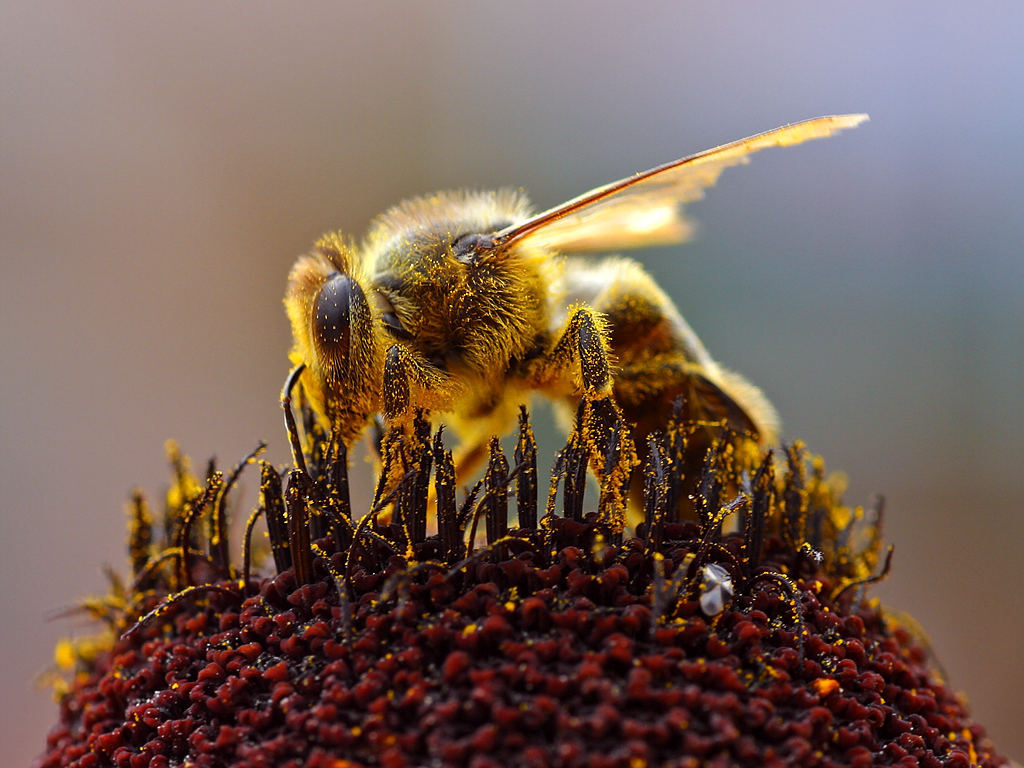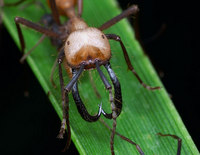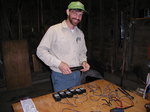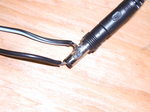|
|
Dear All,
This is Andy McCall, I am studying pollination and herbivory with Stuart and Ruth and am based, this summer, at Denison University, where I teach.
You may remember me through my witty or witless posts last year on this flog; it has been a long time since I have posted anything, but…
Together with Colin Venner (on the crew last year) and Monique Brown, both of Denison, I have cobbled together a few small videos of pollinators we observed last year. We have over 800h of video to watch and we are more than halfway done!
Anyway, I am going to try and post a few videos of known pollinators and a few unknowns — I would love it if anyone might be able to identify the unknown bee — we have several, but it is hard sometimes to see characteristics on the video.
I hope the flowering commences soon!
yours, Andy
We forgot our list of what specific heads to video for each plant, so I decided, in the field, to just video the one with a twist tie color that comes first in the alphabet. I think we’ll use this method from now on as it is at least haphazard and it’s easy to remember.
Also, three of our rigged batteries failed immediately. I hope my big batteries from B and H come soon!
Video Andy
Here are some preliminary instructions on how to observe and record bee/ant presence or absence while we are doing phenology measurements. I thought that while we are looking so closely at each head, we might as well try to garner some information on the Hymenopteran vistors as well. It will not be continuous data, but rather a simple ‘yes’ or ‘no’ measurement for each plant (bees) or for each head (ants).

Bee collecting composite pollen, copyright Jon Sullivan
For BEES:
As you begin your phenology measurements only scan for bees once you are within 1m of the plant. If there are any moving, active bees on any head, mark the appropriate box in your phenology form. As soon as you touch a head for phenology measurements, stop recording any bee presence/absence. So, if you are looking at a head and a bee lands on an adjacent head, just ignore it. For bees, we are interested in bee presence for the ENTIRE plant, so as soon as you see one, you are finished entering data.
Remember, wee are only interested in active bees, so don’t count sleeping bees, dead bees, bees caught by crab spiders or assassin bugs, etc.

Ant, copyright Alex Wild
For ANTS:
Ant data are collected on a per-head basis. As you take each head into your hand and begin your anther count, notice if you see any ants on the top of the inflorescence (either ray OR disk florets). Don’t make any special effort at looking underneath the inflorescence. If no ants make an appearance as you are handling the head, mark the head as having no ants, if ANY ants appear whilst you are searching the head, enter the data as such.
Andy

Hello everyone, this is Andy McCall reporting from the farmhouse in Douglas Co. Minnesota.
I’m currently an assistant professor of biology at Denison University, a small liberal arts college (a SLAC!) in Granville, Ohio. I, like many people on the project, graduated from Carleton College , where I first learned to appreciate and love the prairie landscape under the tutelage of Mark Mckone .
Needless to say, I love teaching and learning and have wanted to be a professor since my time at Carleton. After Carleton, I studied alpine flies in New Zealand while earning my Master’s degree at the University of Canterbury, leafcutter ants in Costa Rica, and wild radishes in California.
I received my doctorate in population biology from UC-Davis in 2006 with Rick Karban and spent some time in Ruth Shaw’s lab at the University of Minnesota last summer, thinking about inbreeding, flowers, and insects — a few of my favorite things! I met Ruth when she came to UC-Davis for a week as a workshop speaker in the Center for Population Biology and we immediately hit it off because we both have done work on the lovely annual plant, Nemophila menziesii . She introduced me to Stuart and the Echinacea project, and the rest is history!
Ruth, Stuart, and I were lucky enough to receive funding through the National Science Foundation to support our work on pollination and seed predation this summer, and I have received generous funds from Denison and the Battelle Foundation to support the students I brought from Denison this year: Josh Drizin, Jameson Pfeil, and Colin Venner. I’m psyched to be part of the project as I am certain that we are learning brand-new things about both Echinacea biology and prairie restoration.
Well, here are some pics from our night of terror in the barn.

Stuart about to void the warranty on the camcorders

Josh trying to hack the transformer

Closeup of soldering job
Well, I got to the farmhouse early to get ready for videorecording. Put the tripods in the big blue tubs for easy transport to the common garden, and then worked on getting random assignments of plants, which were kindly printed out by Stuart.
After assigning plants to different cameras, Colin and I walked briskly to the CG to set up everything. It took much longer than expected, partly because it was the first time and partly because I am really slow. I’m not sure why — I like to be careful and I have always been the slow one in the field, oh well.
One camera did not work after plugging in the doctored battery, so we pondered over it for quite a while. What was more alarming was that even the Sony-supplied battery stopped working in that particular recorder! I was worried at that point, so we tried another Sony battery and camcorder along with the doctored battery and the same horrible thing happened again — no recording and the original battery stopped working! So, we hightailed it back to the farmhouse to figure things out.
After trying different combos of batteries, doctored connectors, and such, we determined that one of the doctored batteries was to blame. Either it wasn’t charged enough, or maybe too much — I will have to check with the voltmeter to find out for sure. It was a relief to know that nothing was permanently damaged — I am nervous about this whole enterprise as it has been quite expensive! But, I am hoping that the data will be worth it.
Andy
Here is a draft for the video protocol. I’d love any useful comments you may have; it is definitely a work in progress, so if you read something and it isn’t clear, please let me know and I will change it. Thanks, A.M.
Protocol for recording pollinators:
v.1.0 (Jun 27 2007)
Equipment:
List of heads to video
A few (~5) pin flags
Five 3 x 5 in. cards and a sharpie
Set of camcorders and battery packs
A radio
1. Get a list of heads that need to recorded from Andy the evening prior to the actual recording date. Each person will be responsible for 3-4 heads for that recording day.
2. Get to the farmhouse at 8am sharp so that you can start recording for sure by 9am.
3. Make a list of ‘cue cards’ for each head that you are to record. This involves writing:
plant location (row and position), color of twist tie and date on a 3 x 5 in. card. This is the first thing you will ‘film’ when going out to the CG, so that we can match up videos to the correct file.
4. Go to each head on the list and make sure that it is still flowering. If not, then add another plant (we’ll supply > 5 heads per list), and make a note that the originally selected head is not flowering. If the plant IS flowering, then place a flag next to it so that you can find it easily. Go to the next head on the list.
5. Next, get the correct camcorder and battery (labeled A-J), put it on a tripod and put it in position over the inflorescence (head). The ideal distance is about 1 ft. away from the head with the camera zoom at about ½ max. zoom. You should be able to see the entire head; try to imagine identifying bees using your recorded image and adjust accordingly. Take a quick video of your ‘cue card’ for each head and then turn off the camera.
Set up all of your cameras first, before starting to record for pollinators. We want to start them all at the same time, so you will need to coordinate with other members of TEAM VIDEO to start synchronously (using your radios).
Make sure that there are no big branches, stems, twigs, etc. that could possibly wave in front of the camera, thus obscuring the inflorescence.
6. At more or less the same time, go to each camera and press the red ‘record’ button. Then, skedaddle away so that you don’t influence the pollinators!
7. At 4pm, go and stop each camera. Disconnect the batteries and return the camcorders and batteries to Andy. He’ll upload the video to a PC and re-charge the batteries for the next round of filming!
Dear flogophiles:
I’m trying to devise ways of measuring FA (see previous post) on our plants. Ideally, we would want measurements on several different organs or parts because if, for example, inbred plants are more developmentally unstable, it would be more convincing if they were more asymmetric in both leaves and inflorescences.
Colin is designing (and hopefully testing) the picture-taking rig for flowering heads. But, I think that it can also be used to take pics of leaves. The trick is getting the leaf to lie flat on the backing of the rig. I was thinking of buying a hand-held scanner to scan leaves in the field, but that takes 4-8 seconds per leaf, and it seems easier and quicker to just snap a picture. Also, I am not sure where measurement error would come from if you scanned the actual leaf.
My biggest concern is getting the inflorescence to lie flat on the rig backing. It is important to get the ray florets nice and flat against the backing or else you could be mis-measuring things pretty easily. I almost think it may be easier to actual measure the ray florets using calipers in the field — it would certainly be more accurate but would also take a bit longer, and you couldn’t really measure ALL the ray florets per head — it would take WAY too long.
If the rig doesn’t work, we could have three people go out with calipers, one after another, measuring the same heads and leaves per plant. You could only measure perhaps 4 ray florets per head, but this is probably OK. This could probably be done in one day! If we could get a pendragon form for this measurement, it would be great, too. So, then you would have the measurements, as well as error that could be assigned to individual observers.
One more thing: We can measure asymmetry in the actual inflorescence by measuring the length of the ray florets, but we could also measure asymmetry WITHIN each ray floret, by measuring the L-R sides. This is what has to be done for the leaves becuase they are naturally asymmetric about the stem of the plant anyway due to differences in leaf age.
OK, my thoughts for now. Things are very exciting here, I hope to get my batteries in the next 2 days so that we can get the cameras up and running by Sunday. Science is happening!
Andy McCall
Trying to make sense of the batteries!
For the camcorders, the batteries themselves carry a charge of 7.2V and 4.9 Wh. But, the AC adapter’s output is 8.4V and 1.7A. Which to use? Perhaps the adapter is higher because there is some resistance in the cord going to the camcorder, but maybe I am just making that up.
Here is a link to a promising product, a 8.4V NiMh battery with a charger included! 40 bucks, though, so it would be $400 for all 10 cameras. Well, this may be worth it…would love your thoughts on this, SW.
There is a nice primer on choosing batteries here.
For our purposes, we can calculate battery capacity using the formula:
Ah = Watts x Time (h) you want to run the camera / voltage needed for the camera
So,
Ah = 3W x 8h / 7.2 V = roughly 3.3 Ah or 3300 mAh
Here’s a nice closeup of styles waving in the breeze and some shameless anthers shedding pollen:

Dearest floggers:
Well, it is 7am on my day off, but I can’t stop thinking about science and the possibilities to learn more about how Echinacea fares in the rich community we have in the common garden. Florid, yes, but I am pretty excited about possible data. It is like gold.
Truly, there are tons of projects to do, but the trick is to find the ones that:
1) Can be done in a timely manner,
2) Are interesting and important in advancing our knowledge about Echinacea and prairie plants in general,
3) Are educational for the students (and researchers!),
4) Can be repeated well into the future of the CG or remnants, and
5), Have a good chance of filling a gap in the literature so they can be published in good journals (this, of course, is related to #2).
This last point is not crucial in the moral sense, but crucial in the practical sense, as papers are the currency of our profession, as my advisor, Rick Karban, once told me.
Anywho, as we do phenology every other day it occurred to me that we could also quantify the percentage of ray florets with herbivore damage at the same time. Perhaps some genotypes accrue damage faster than others…I’m not sure if many researchers have looked at florivory over time in such detail. There seems to be quite a bit of damage this year. I did some ‘quick and dirty’ sampling last year, but did not have the plant IDs recorded, DOH , oh well, live and learn.
We also have to figure out how to measure fluctuating asymmetry (FA) so that we have multiple measurements to account for measurement error. Measurement error is important to quantify because the small deviations from symmetry that we may observe may smaller in magnitude than our error, but we can’t know unless we have replicate measurments! One way to do it is to take several pictures of the same plant, perhaps by different people. Or, you could have several people measure the same plant. Also, I wonder if FA changes with phenology or with organ under consideration…
Stuart and I are going to try and run electrical cord from the granary to the CG so that we can run the videocameras for a good long time each day. It is 120m from the granary to the SE corner of the garden, so this will take lots of cord to complete. Since I know very little about electrical wiring, save that you shouldn’t stick live wires into tubs of water, I will wait until Stuart gets some advice in Chicago before diving in.
BTW, I took video of the biggest plant in the CG yesterday and didn’t see any pollinators in 90 minutes of filming, so perhaps an even longer interval would be better to get good, non-zero data.
Signing off until this afternoon. I never knew I would like blogs, but they are useful, especially if people read them (hem hem)
Reminders:
We should measure style persistence as a measure of pollen limitation when we can (perhaps on Tuesday). Also, damage to ray florets would be excellent to measure. I wonder if damage to ray florets has greater indirect effects through reduced pollination than the direct damage to styles that we have seen?!
😉 Andy
|
|






